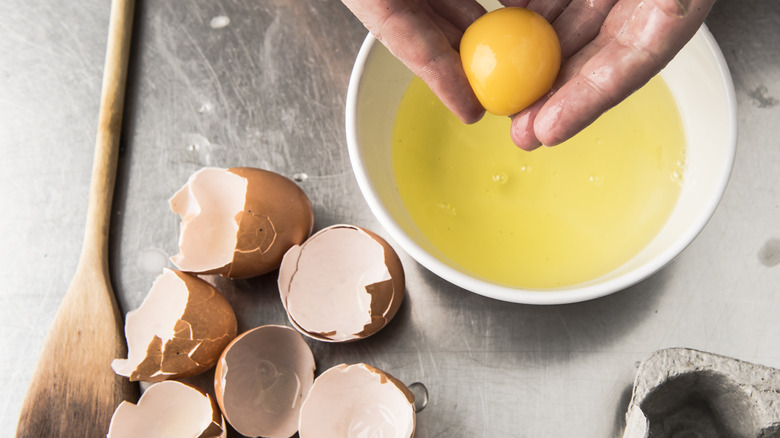Is There A Difference Between Frozen Yogurt And Custard?
When it comes to frozen desserts, there is no shortage of options. But if you find yourself in the frozen foods section of the grocery store staring at cartons of frozen yogurt and frozen custard wondering what the heck the difference is and which one you should choose, hopefully we can help. Ultimately, which dessert you end up picking is based on personal preference, but the major difference lies with the ingredients. Frozen yogurt is exactly what it sounds like — a yogurt-based treat with some added milk, cream, and sugar. Frozen custard, on the other hand, is made with milk, cream, sugar, and egg yolks — 1.4% egg yolk by weight, to be specific, according to the U.S. Food and Drug Administration. It must also have at least 10% milk fat by weight to qualify as a custard.
The addition of egg yolks in frozen custard means it has a higher fat content. Frozen yogurt has garnered a reputation over the years as being a healthier alternative to ice cream or custard, and while it does have less fat and is packed with gut-healthy probiotics, it typically contains a lot of added sugars (especially if you go crazy with toppings at a self-serve froyo place) to make the tangy flavor of yogurt more palatable to a broader audience.
The difference is noticeable in both taste and texture
If you're unbothered by fat and sugar content and want to pick your dessert solely based on taste and texture, it's important to note that there are noticeable differences between the two, all thanks to the egg yolks (or lack thereof). Frozen yogurt will taste like a sweeter version of regular yogurt, so it will have some slight tartness to it. The omission of egg yolks means frozen yogurt has a lighter, airier texture. It is also typically churned quicker than a custard, which means it contains more air. This leads to a fluffier frozen yogurt.
Egg yolks are used to add an element of creaminess to many different desserts, and custard is no different. The fats and protein in egg yolks thicken the custard's base and act as an emulsifier to keep the ingredients smooth and perfectly creamy. This results in a rich and decadent dessert. Additionally, custard-making machines churn the mixture slowly, and less air is whipped into the finished product. Less air during the churning process also contributes to the density and velvety texture of a frozen custard. So, the choice is yours — frozen yogurt is a lighter option with a tangy flavor, while frozen custard is definitely more of an indulgence. Either way, both of these frozen treats are cold, creamy, and will certainly satisfy your sweet tooth.

